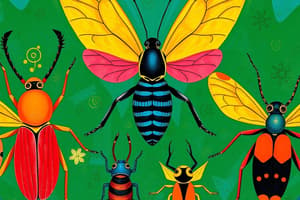Podcast
Questions and Answers
What is the significant benefit of using black soldier fly larvae in animal feed?
What is the significant benefit of using black soldier fly larvae in animal feed?
- They can convert food waste and manure into high-quality protein. (correct)
- They have a higher growth rate than fish meal.
- They are higher in calories compared to traditional feeds.
- They require less water for growth than other feed sources.
What is the protein content of defatted black soldier fly meal based on dry matter reported by Cullere et al. in 2016?
What is the protein content of defatted black soldier fly meal based on dry matter reported by Cullere et al. in 2016?
- 51.8% (correct)
- 47.2%
- 36.2%
- 14.8%
Which stage of the black soldier fly larvae is processed for creating insect meal?
Which stage of the black soldier fly larvae is processed for creating insect meal?
- Eggs
- Prepupal (correct)
- Pupa
- Larvae
At what temperature are the black soldier fly larvae killed during processing?
At what temperature are the black soldier fly larvae killed during processing?
What is the lipid content of full-fat black soldier fly meal as reported by Barroso et al. in 2014?
What is the lipid content of full-fat black soldier fly meal as reported by Barroso et al. in 2014?
How long are the prepupal black soldier fly larvae oven dried?
How long are the prepupal black soldier fly larvae oven dried?
Which region is the natural habitat of the black soldier fly?
Which region is the natural habitat of the black soldier fly?
What happens to the press cake after the black soldier fly larvae are defatted?
What happens to the press cake after the black soldier fly larvae are defatted?
What was the outcome of replacing fishmeal with insect meal in the experiment?
What was the outcome of replacing fishmeal with insect meal in the experiment?
What potential issue could arise from using insect meal as a fish feed over an entire production cycle?
What potential issue could arise from using insect meal as a fish feed over an entire production cycle?
Why is the demand for high-quality feed ingredients growing in aquaculture?
Why is the demand for high-quality feed ingredients growing in aquaculture?
What is a potential benefit of using fishmeal sourced from trimmings or sustainability schemes?
What is a potential benefit of using fishmeal sourced from trimmings or sustainability schemes?
Which of the following is NOT a directive or standard mentioned concerning aquaculture?
Which of the following is NOT a directive or standard mentioned concerning aquaculture?
What is a major characteristic of fishmeal required for organic aquaculture?
What is a major characteristic of fishmeal required for organic aquaculture?
What impact does the limited availability of fishmeal have on aquaculture?
What impact does the limited availability of fishmeal have on aquaculture?
What effect does the type of protein source have on organoleptic properties?
What effect does the type of protein source have on organoleptic properties?
What is the digestible energy content of the feed used for H. illucens larvae?
What is the digestible energy content of the feed used for H. illucens larvae?
What is the DP:DE ratio found in the study?
What is the DP:DE ratio found in the study?
How long were the larvae fed before reaching the second larval stage?
How long were the larvae fed before reaching the second larval stage?
What type of feed was used for the larvae in this study?
What type of feed was used for the larvae in this study?
Which factor might influence the growth performance of H. illucens larvae?
Which factor might influence the growth performance of H. illucens larvae?
What is the likely source of crude protein mentioned in the content?
What is the likely source of crude protein mentioned in the content?
What happens to larvae after 10 days of feeding?
What happens to larvae after 10 days of feeding?
What aspect of insect meal production is notably important for diets in aquaculture?
What aspect of insect meal production is notably important for diets in aquaculture?
Flashcards are hidden until you start studying
Study Notes
Insect Feed in Livestock Production
- Interest in insects, particularly larvae, as feed for livestock is rapidly increasing.
- Black soldier fly (Hermetia illucens) is a promising insect species for feed conversion from food waste and manure into high-quality protein.
- Native to Central and Latin America, H. illucens is now established in most tropical regions worldwide.
Nutritional Profile of H. illucens
- Protein and lipid content of defatted H. illucens meal (HIM) ranges significantly:
- 47.2% protein and 11.8% lipid (Kroeckel et al., 2012)
- 51.8% protein and 14.8% lipid (Cullere et al., 2016)
- Full-fat HIM contains 36.2% protein and 18.0% lipid (Barroso et al., 2014).
Diets and Experimental Results
- Experimental diets included one commercial and one experimental formulation.
- Replacement of fishmeal with insect meal showed no adverse effects on growth, feed conversion, or product quality.
- Reduced protein utilization efficiency in fish fed with HIM may impact overall production over a full production cycle.
Aquaculture and Protein Sources
- Aquaculture contributes significantly to global fish supply, with about 50% of food fish being produced through aquaculture as of 2006.
- Global finfish production rose by 90% from 2004 to 2014, driving demand for high-quality, protein-rich feed ingredients.
- Organic aquaculture requires that all feed ingredients be organically or sustainably certified, limiting available resources and affecting prices.
Technical Findings
- H. illucens larvae were fed chicken feed until the second larval stage, demonstrating a controlled feeding process.
- Digestible Energy (DE) values and the digestible protein to digestible energy (DP:DE) ratio aid in evaluating feed efficiency, indicating potential variations in performance based on dietary composition.
Studying That Suits You
Use AI to generate personalized quizzes and flashcards to suit your learning preferences.




